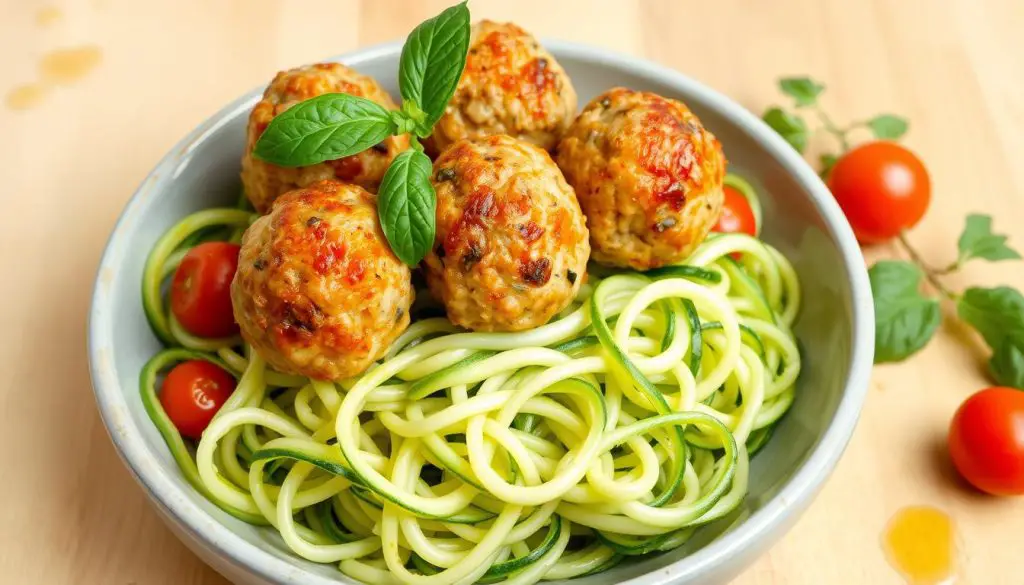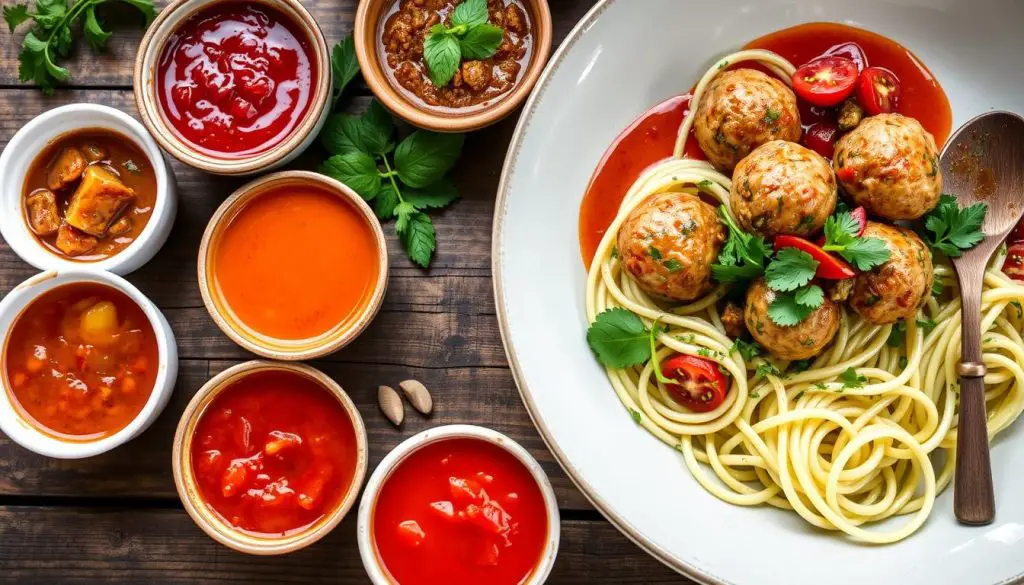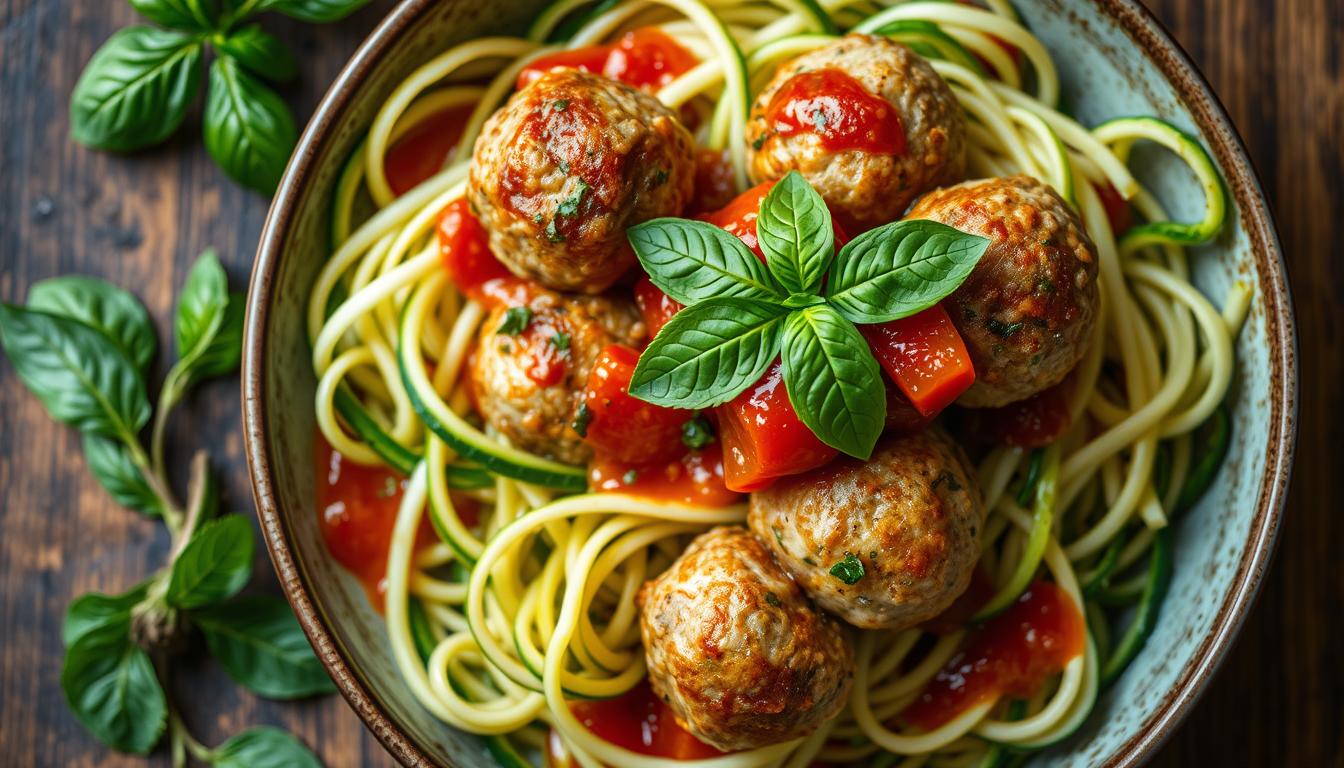Are you tired of searching for meals that help with fibromyalgia and taste good? We have a recipe that does just that. It’s a tasty mix of turkey meatballs with zucchini noodles. This dish could be a big help in managing your fibromyalgia.
Did you know that only a small percent of people have gluten-related illnesses? Yet, gluten-free diets are getting more popular. This recipe is gluten-free and low-carb. It’s great for those with fibromyalgia symptoms like bloating and muscle aches.
This dish is packed with anti-inflammatory ingredients. They can help reduce your chronic pain. Let’s look at how this meal can become a key part of your diet.
Understanding Fibromyalgia and Its Impact
Symptoms and Challenges of Fibromyalgia
Fibromyalgia is a chronic condition that affects millions. It causes widespread pain, fatigue, and sleep issues. People with fibromyalgia also struggle with memory and concentration problems.
Living with fibromyalgia is tough. It can make everyday life hard. The symptoms can really hurt a person’s quality of life.
Some common symptoms of fibromyalgia include:
- Chronic, widespread pain in the muscles, joints, and soft tissues
- Extreme fatigue and lack of energy
- Difficulty sleeping or non-restorative sleep
- Memory and concentration problems
- Headaches and migraines
- Sensitivity to touch, temperature, and loud noises
- Irritable bowel syndrome (IBS) and other digestive issues
Fibromyalgia can make life hard in many ways. It affects physical, emotional, and social health. People with fibromyalgia often face unpredictable symptoms and stigma.
How Diet Can Help Manage Fibromyalgia
There’s no cure for fibromyalgia, but diet and nutrition help manage symptoms. An anti-inflammatory diet can reduce inflammation and ease symptoms.
By eating anti-inflammatory foods for fibromyalgia, people can feel better. They might have less pain, more energy, and better sleep. This approach can help alongside medical treatment and lifestyle changes.
Anti-Inflammatory Benefits of Turkey Meatballs
Choosing the right foods is key when you have fibromyalgia. Turkey is a great protein that helps fight inflammation. It’s low in fat and full of good nutrients, making it perfect for a fibromyalgia diet.
Turkey is packed with nutrients like selenium, vitamin B6, and niacin. These help reduce body inflammation, a big problem for fibromyalgia patients.
Turkey is also rich in protein, which is vital for muscle health. It helps with muscle pain and fatigue, common in fibromyalgia.
Turkey meatballs are a tasty way to add turkey to your diet. They’re full of anti-inflammatory properties and are easy to add to many meals.
Using turkey in your diet can help with fibromyalgia. It’s a lean protein that supports your health. Enjoy turkey meatballs or other dishes to boost your well-being.
Nutrient-Dense Zucchini Noodles for Fibromyalgia
Managing fibromyalgia can be easier with nutrient-rich foods. Zucchini is a great choice. It’s a low-carb, gluten-free pasta substitute. It’s packed with vitamins, minerals, and antioxidants that fight inflammation and boost health.
Low-Carb and Gluten-Free Alternatives
Zucchini is perfect for those with fibromyalgia on a special diet. It’s low in carbs and gluten-free. It’s also full of vitamin C, vitamin B6, and potassium, which are key for health and reducing inflammation.
There are other low-carb, gluten-free pasta options too. Shirataki noodles, spaghetti squash, and kelp noodles are great alternatives. They make for a nutritious base for your meals.
Adding these nutrient-dense vegetables to your diet is a smart move. Zucchini noodles and similar options are not just tasty. They also help manage fibromyalgia symptoms. They make it easy to eat healthier every day.
Turkey Meatballs with Zucchini Noodles for Fibromyalgia
For those with fibromyalgia, finding tasty meals that help manage symptoms is key. This recipe for turkey meatballs with zucchini noodles is designed to be fibromyalgia-friendly. It combines anti-inflammatory turkey and nutrient-rich zucchini for a nourishing meal.
Fibromyalgia causes widespread pain, fatigue, and other symptoms. While there’s no cure, diet can help manage it. Eating anti-inflammatory foods and avoiding triggers can improve well-being.
| Key Nutrients for Fibromyalgia | Benefits |
|---|---|
| Antioxidants | Help reduce inflammation and oxidative stress |
| Vitamin B12 | Supports energy production and nerve function |
| Magnesium | Helps relax muscles and reduce pain |
| Omega-3 fatty acids | Have anti-inflammatory properties |
This turkey meatballs and zucchini noodles dish is gluten-free and low-carb. It’s packed with nutrients to help manage fibromyalgia symptoms. It’s a great choice for those looking for anti-inflammatory meals.

Adding this turkey meatballs with zucchini noodles recipe to your meals can boost your health. It’s a delicious way to nourish your body and find relief from fibromyalgia’s challenges.
Preparing the Turkey Meatball Mixture
To make the perfect turkey meatballs, start by mixing the key ingredients for turkey meatballs. In a big bowl, mix ground turkey, breadcrumbs, eggs, garlic, and seasonings for turkey meatballs like dried oregano, basil, salt, and pepper. Breadcrumbs and eggs help the mixture stick together, making the meatballs tender and cohesive.
After mixing well, shape the mixture into even-sized meatballs. This is important for even cooking. Use a small cookie scoop or spoon to portion the mixture. Then, roll each portion between your palms to make smooth, round meatballs.
Feel free to add flavor enhancers to your turkey meatballs. Try adding grated Parmesan cheese, finely chopped fresh herbs, or a bit of low-sodium soy sauce or Worcestershire sauce for extra flavor. The goal is to find a balance of seasonings that enhance the turkey’s natural taste.
By carefully preparing the turkey meatball mixture, you’re on your way to a tasty and healthy meal. This meal will not only please your taste buds but also support your health.
Creating Zucchini Noodles for the Dish
This recipe uses zucchini noodles as a base. They are gluten-free and low in carbs. Making zucchini noodles is easy with the right tools and techniques. Let’s look at how to prepare perfect zucchini noodles for your meal.
Selecting and Prepping the Zucchini
Choose fresh, firm zucchini for your noodles. Look for straight, uniform shapes. This makes it easier to get even noodles. Wash the zucchini well and dry it with a towel or paper towels.
Cutting Zucchini Noodles
- Use a spiralizer: This tool turns zucchini into long noodles. Just twist the handle to create your noodles.
- Try a julienne peeler: If you don’t have a spiralizer, a julienne peeler works too. Run it down the zucchini to get long strips.
- Slice with a knife: For a rustic look, use a sharp knife. Slice the zucchini into long, thin strips.
Preparing the Zucchini Noodles
After cutting the zucchini, prepare it right for the best texture. Here are some tips:
- Pat the noodles dry with paper towels to remove moisture.
- Trim long noodles to a shorter length if needed.
- For a firmer texture, sauté the noodles in a pan with a bit of oil or butter before adding them to the dish.
By following these steps, you’ll make delicious and healthy zucchini noodles. They pair well with turkey meatballs for a great meal.

Cooking the Turkey Meatballs and Zucchini Noodles
Tips for Perfectly Cooked Meatballs and Noodles
Getting your turkey meatballs and zucchini noodles just right is key for a great meal. Here are some tips to help you cook them perfectly.
To cook the turkey meatballs, start by heating your oven to 375°F (190°C). Make the meatballs into even-sized balls and place them on a baking sheet with parchment paper. Bake for 15-20 minutes, or until they’re fully cooked and the internal temperature hits 165°F (75°C). Make sure not to overcrowd the baking sheet for even cooking.
For the zucchini noodles, you can use a spiralizer, a julienne peeler, or a sharp knife. Spiralize, julienne, or slice the zucchini into long, thin noodles. To cook, sauté them in a pan with a bit of oil or broth over medium-high heat for 2-3 minutes. They should be tender but not too soft.
- Preheat oven to 375°F (190°C) for the turkey meatballs
- Bake the meatballs for 15-20 minutes, or until cooked through and reach an internal temperature of 165°F (75°C)
- Spiralize, julienne, or thinly slice the zucchini to create the noodles
- Sauté the zucchini noodles in a pan with a small amount of oil or broth for 2-3 minutes, until tender but slightly firm
By following these tips, you can make sure your turkey meatballs and zucchini noodles are cooked just right. They’ll be ready to be combined into a tasty, fibromyalgia-friendly meal.
Healthy Sauce Options for the Dish
Make your turkey meatballs and zucchini noodles even better with healthy sauces. These sauces add flavor and important nutrients. They help manage fibromyalgia. You can make your own or buy them.
Homemade Sauce Recipes
Try these easy, fibromyalgia-friendly sauces for your meatballs and noodles:
- Basil Pesto – Mix fresh basil, olive oil, garlic, pine nuts, and Parmesan cheese for a tasty sauce.
- Tomato Sauce with Herbs – Cook diced tomatoes, garlic, oregano, and basil for a sauce full of antioxidants.
- Creamy Avocado Sauce – Blend avocado, lemon juice, garlic, and olive oil for a smooth sauce.
Store-Bought Sauce Options
For easy options, try these store-bought sauces with your turkey meatballs and noodles:
- Primal Kitchen Lemon Garlic Dressing – A tangy dressing with healthy fats and no sugars.
- Tessemae’s Lemon Chesapeake Dressing – A citrusy sauce with omega-3s and no artificial stuff.
- Organicville Marinara Sauce – A simple marinara low in sugar and full of tomato antioxidants.
Try these sauces to make your meal more flavorful and fibromyalgia-friendly.

Serving and Garnishing the Fibromyalgia-Friendly Meal
Presenting your turkey meatballs with zucchini noodles in a way that looks good can make the meal better. Here are some tips to help you serve and garnish this delicious meal:
Start by neatly arranging the turkey meatballs and zucchini noodles on a plate or shallow bowl. Make sure they’re evenly spread out for a balanced look. The green zucchini noodles and brown meatballs make a nice contrast, making the dish more appealing.
Adding garnishes can make the dish look better and taste even better. Try using fresh herbs like basil, parsley, or oregano for color and smell. A sprinkle of Parmesan cheese or toasted breadcrumbs adds texture and flavor.
For a bit of brightness, add a lemon wedge or a drizzle of fresh lemon juice. It balances the richness of the meatballs. You can also serve it with roasted garlic or caramelized onions for more flavor and a sweet contrast.
The goal is to make the dish look good and show off its health benefits. By focusing on plating and garnishing, you can make the how to serve turkey meatballs and zucchini noodles experience better. It turns the meal into a truly fibromyalgia-friendly dish.
| Garnish | Benefit for Fibromyalgia |
|---|---|
| Fresh Herbs (Basil, Parsley, Oregano) | Herbs contain anti-inflammatory properties and can help reduce pain and inflammation associated with fibromyalgia. |
| Grated Parmesan Cheese | Parmesan cheese is a good source of calcium, which is important for bone health and can help alleviate muscle cramps in fibromyalgia patients. |
| Lemon Wedge | Lemons are rich in vitamin C, which can help boost the immune system and reduce inflammation in fibromyalgia. |
| Roasted Garlic | Garlic has antimicrobial and anti-inflammatory properties that can be beneficial for fibromyalgia management. |
| Caramelized Onions | Onions contain quercetin, a flavonoid with anti-inflammatory effects that may help alleviate fibromyalgia symptoms. |
Meal Prep and Batch Cooking Tips
Meal prep and cooking can be tough for those with fibromyalgia. The condition makes physical and mental tasks hard. But, with some planning, you can make it easier. Here are tips for prepping and cooking the turkey meatballs and zucchini noodle dish to help manage fibromyalgia.
Start by preparing parts of the dish early. You can make the meatball mix and portion it, or spiralize the zucchini noodles. This way, you save time and effort when it’s time to cook.
Storing the dish properly is key to keeping it fresh. Portion the cooked meatballs and noodles into servings. Store them in airtight containers in the fridge or freezer. This makes reheating easy and quick.
When reheating, use quick methods like the microwave or oven. This saves you from long cooking times. Always check the meatballs’ internal temperature to ensure they’re cooked well.
Using these tips, the turkey meatballs and zucchini noodle dish can be a great option for managing fibromyalgia. A bit of prep work means you can enjoy a healthy meal with little effort. This frees up time for other important self-care activities.
Incorporating More Anti-Inflammatory Foods
If you have fibromyalgia, adding more anti-inflammatory foods to your diet can really help. The turkey meatball and zucchini noodle dish we talked about is a great start. But, there are many other foods that can reduce inflammation and make you feel better.
Fibromyalgia-Friendly Ingredient Substitutions
One easy way to make your diet better is to swap out ingredients. Here are some good swaps:
- Replace refined grains with whole grains like brown rice, quinoa, and oats.
- Swap out vegetable oils for anti-inflammatory options like extra-virgin olive oil or avocado oil.
- Use herbs and spices liberally to add flavor without relying on salt or sugar.
- Opt for lean protein sources like chicken, turkey, or fish instead of red meat.
- Incorporate more anti-inflammatory fruits and vegetables, such as berries, leafy greens, and cruciferous veggies.
By making these swaps, you can create a diet full of foods that are good for fibromyalgia. This will help nourish your body and manage inflammation.

You can also try new recipes with different anti-inflammatory foods. There are endless options, from soups and salads to stir-fries and baked dishes. This way, you can enjoy a variety of tastes while supporting your health.
Remember, finding the right diet for fibromyalgia is a personal journey. Try different ingredients and recipes, and see how your body reacts. With a little creativity and a focus on nourishing your body, you can live a healthier, more vibrant life.
Balancing Nutrition for Fibromyalgia Management
For those with fibromyalgia, eating a balanced diet is key. It helps manage symptoms and boosts health. It’s important to balance protein, carbs, and fats. Vitamins and minerals also play a big role in managing fibromyalgia.
Adding a variety of nutrient-rich foods to your meals is essential. This ensures your body gets the nourishment it needs to thrive.
It’s important to avoid dietary excitotoxins like MSG for those with fibromyalgia. These can make symptoms worse. Choose whole, unprocessed foods over processed ones. Your turkey meatballs and zucchini noodles dish is a great example of a nutrition for fibromyalgia meal.
| Macronutrient | Fibromyalgia-Friendly Considerations |
|---|---|
| Protein | Lean proteins like turkey, chicken, and fish can help support muscle health and recovery. |
| Carbohydrates | Complex carbohydrates from whole grains, fruits, and vegetables provide sustained energy and fiber for digestive health. |
| Fats | Healthy fats, such as those found in avocados, nuts, and olive oil, can help reduce inflammation and promote overall well-being. |
It’s also important to focus on micronutrients for managing fibromyalgia. Foods rich in omega-3s and vitamin D can help reduce inflammation and improve health.
By focusing on a balanced diet for fibromyalgia, you can ensure your body gets the macronutrient considerations for fibromyalgia it needs. Remember, a personalized approach may be necessary. Consult with a healthcare professional or registered dietitian to develop a nutrition for fibromyalgia plan that works best for you.
Lifestyle Adjustments for Fibromyalgia Relief
Managing fibromyalgia is more than just eating right. It’s about making big changes in your life. By changing how you live, you can feel better and live better.
Exercise is a big part of this. Even small activities like yoga or swimming can help a lot. They make you more flexible, reduce pain, and give you more energy.
- Start with 20-30 minutes of gentle exercise a few times a week. This helps you get stronger slowly.
- Don’t push yourself too hard. Too much exercise can make things worse.
- Try stretching and mindfulness practices like meditation. They help with your holistic approach to fibromyalgia.
Stress is also very important. Too much stress can make fibromyalgia symptoms worse. Find ways to relax, like deep breathing or guided imagery. This helps your body and mind relax.
Don’t forget about sleep. Fibromyalgia can mess with your sleep, making you tired and in pain. Try to sleep well by sticking to a routine and making your bedroom comfy. You can also use melatonin to help you sleep better.
By making these changes – from exercising and managing stress to sleeping well – you can fight fibromyalgia symptoms better. Remember, small steps can lead to big improvements in your life.
Building a Fibromyalgia-Friendly Recipe Collection
Living with fibromyalgia means finding recipes that meet your dietary needs and help manage symptoms. The turkey meatballs with zucchini noodles recipe is a great example of fibromyalgia-friendly recipes you can try. To create a big collection of recipe ideas for fibromyalgia, follow these tips:
- Look for online resources and recipe blogs focused on fibromyalgia-friendly recipes. These sites offer a variety of dishes that are anti-inflammatory, gluten-free, and low in carbs. They help expand your fibromyalgia meal options.
- Talk to your healthcare provider or a registered dietitian to learn about your dietary needs. Use this info to pick recipes that are right for you.
- Try new ingredients and cooking methods that fit your diet. Add your own twist to recipes to make them taste better and help manage your symptoms.
- Keep your fibromyalgia-friendly recipes organized. Use a digital folder, a physical binder, or a Pinterest board. This makes it easy to find and use these recipes in your meal planning.
Building a diverse collection of recipe ideas for fibromyalgia lets you manage your condition with healthy, tasty meals. Take the chance to expand your fibromyalgia meal options and feed your body with foods that support your health.
Finding Support and Resources for Fibromyalgia
Living with fibromyalgia can feel tough and isolating. But, you’re not alone. Many support groups and resources are here to help. By connecting with others who face similar challenges, you can find strength and support.
Look into organizations like the National Fibromyalgia Association and the Fibromyalgia Action UK. They offer educational materials, support groups, and ways to meet others with fibromyalgia. These groups can help you learn how to manage symptoms and find local help.
Online forums and social media groups are also great for support. Here, you can share your story, ask for advice, and find understanding. These connections can make you feel less alone and give you a sense of community.
Source Links
- https://betterme.world/articles/gluten-free-diet-plan-for-beginners/
- https://rejoicenutritionwellness.com/10-nutrients-for-anxiety-stress-management/
- https://www.healthline.com/nutrition/no-carb-diet
- http://tmj.org/wp-content/uploads/2020/08/TMJ_nutrition_Guide.pdf
- https://www.healthline.com/nutrition/easy-healthy-meals
- https://fullyfunctional.com/blog/category/all/
- https://nourishingmeals.com/search?updated-max=2014-11-14T10:58:00-08:00&max-results=6&reverse-paginate=true&m=1&search=&page=33
- https://www.healthline.com/nutrition/healthy-lunch-ideas-for-weight-loss
- http://www.wellnesschiro.com/images/healthline/Volume 19 Number 1 January_February_2008.pdf
- https://thedefineddish.com/vietnamese-inspired-whole30-meatball-pho/
- https://www.aol.com/65-best-healthy-recipes-weight-133027848.html
- https://www.beingfibromom.com/monthly-fibromyalgia-meals-january-2017/
- https://www.healthline.com/nutrition/lchf-diet-plan-and-menu
- https://mariamindbodyhealth.com/slow-cooker-beef-broccoli/
- https://www.healthline.com/nutrition/dr-nowzaradan-diet
- https://www.kojo-designs.com/2012/04/getting-organized-a-whole-months-worth-of-meals-via-crockpot-freezer-cooking/
- https://www.linkedin.com/pulse/cooking-one-part-three-well-stocked-kitchen-alex-brecher
- https://www.healthline.com/nutrition/hypothyroidism-diet
- https://www.healthline.com/nutrition/candida-diet
- https://carneswellness.com/wp-content/uploads/2018/12/PARASITE-DIET-.pdf
- https://revistas.proeditio.com/jonnpr/article/view/4274/PDF4274
- https://www.everydayhealth.com/diet-nutrition/gluten-free-diet/
- https://autoimmunewellness.com/what-is-autoimmune-paleo/
- https://www.lchf-rd.com/category/blog/page/2/
- https://www.mediterraneanliving.com/21-authentic-mediterranean-food-recipes/
- https://www.epbot.com/2019/04/my-favorite-low-fodmap-meals-one-year.html
- https://www.healthline.com/nutrition/ornish-diet-review
